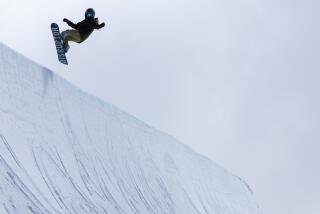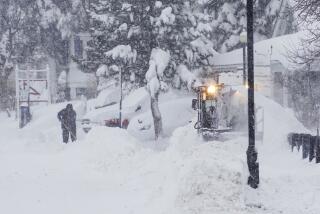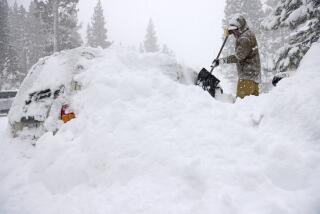No Snowball Effect : Storms Help Ski Sales, but Economy Keeps Increase Below Normal
Skiers are flocking to mountain resorts and ski-equipment shops after the latest winter storms, but they’re not leaving their economic worries at home.
Several resorts and retailers said Monday that although customer traffic is up, business remains weaker than normal after a big storm because of the soft economy. Local resorts said some people are eschewing trips to Colorado or Utah and staying on California slopes to save money.
“As far as my sales volume in dollars, I’m still disappointed,” said Richard Naganuma, who manages the Sunland Skiers outlet in Garden Grove. “We aren’t selling that many more high-ticket items like skis.”
Jeff Jones, owner of Newport Ski Co. in Newport Beach, said business is down about 15% from 1989. “For years, we never noticed a recession whenever there was one,” said Jones, who opened the store 15 years ago. “The ski industry was somewhat immune to recessions.”
At Snow Valley in the San Bernardino Mountains, “the skiing is better than in many years,” thanks to back-to-back storms in California the past few days, said Benno Nager, the resort’s general manager. “But the crowds have not been as large.”
Bob Haueter, vice president of marketing for the Sport Chalet sporting-goods stores, conceded that despite the current upswing in business, the stores’ holiday sales overall remain little changed from last year. But he said ski sales have been as good as sales of less-expensive items such as gloves and socks.
“They’re walking out with skis and boots and bindings,” which as a package can cost more than $500, Haueter said.
The Christmas holidays are typically the busiest season for ski resorts and equipment retailers. In Southern California, it’s the best Christmas in years simply because there’s finally enough snow to draw significant numbers of skiers.
Mammoth Mountain resort opened Oct. 28--one of the earliest openings in its history, said Pam Murphy, assistant marketing director. The latest storms enabled Mammoth to open its highest ski areas Monday, an event that typically sparks a 10% to 20% increase in skiers, she said.
But the snow can’t cover up consumers’ concern about layoffs, skimpy pay raises, credit card bills and the weak economy.
“Business is better than last year because there’s more snow, but it’s still slower than in previous years,” said Seth Mellman, who runs the ski shop for Oshman’s Sporting Goods store in West Los Angeles. “I definitely see the economy having an effect.”
To be sure, skiing equipment can be expensive, and those who can afford to buy the premier brands “are not usually impacted by downturns in the economy,” said Sport Chalet’s Haueter. Mellman agreed but added that “I don’t think we’re selling as many skis in general as we used to.”
It also can be expensive to fly from California to resorts in the Rocky Mountains such as Vail and Aspen, and many local skiers are opting to stay closer to home this year, said Paul Oster, a broker with the Mammoth office of the Re/Max real estate firm. Oster said he has rented temporary quarters to several skiers who wanted to stay in state to cut costs.
“They’re looking for a similar experience at a lesser price,” he said. “A draft beer in a bar in Mammoth costs half what it costs in Vail.”
Still, there are enough skiers who can afford to travel to places such as the Copper Mountain Resort west of Denver, which is “very pleased with the turnout, not only in the skiing but also in the lodging,” said Kelley Davidson, vice president of marketing.
“This will be one of our best holiday seasons ever, if not the best” in Copper Mountain’s 20-year history, he said. “It seems to be strong throughout the state,” which has enjoyed substantial snowfall since November, he said.
Copper Mountain’s guests also are spending more, Davidson said. Customers’ average daily spending per person--not only on skiing but on lodging, restaurants and elsewhere--is up about 15% from last year, he estimated.
Skiers’ spending in Mammoth also is up--about 8% on average--compared to last year, and that does not reflect an increase in ski-lift prices because prices are unchanged, said Murphy.
But Richard Naganuma, manager of the Sunland Skiers store in Garden Grove, said his customers are spending cautiously before they get to the resorts, stocking up mostly on “gloves and goggles, the normal accessory items people pick up before they go to the mountains. You know, the things they lose.”
More to Read
Sign up for The Wild
We’ll help you find the best places to hike, bike and run, as well as the perfect silent spots for meditation and yoga.
You may occasionally receive promotional content from the Los Angeles Times.







